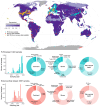A global database of soil microbial phospholipid fatty acids and enzyme activities
- PMID: 41006295
- PMCID: PMC12475190
- DOI: 10.1038/s41597-025-05759-2
A global database of soil microbial phospholipid fatty acids and enzyme activities
Abstract
Soil microbes drive ecosystem function and play a critical role in how ecosystems respond to global change. Research surrounding soil microbial communities has rapidly increased in recent decades, and substantial data relating to phospholipid fatty acids (PLFAs) and potential enzyme activity have been collected and analysed. However, studies have mostly been restricted to local and regional scales, and their accuracy and usefulness are limited by the extent of accessible data. Here we aim to improve data availability by collating a global database of soil PLFA and potential enzyme activity measurements from 12,258 georeferenced samples located across all continents, 5.1% of which have not previously been published. The database contains data relating to 113 PLFAs and 26 enzyme activities, and includes metadata such as sampling date, sample depth, and soil pH, total carbon, and total nitrogen. This database will help researchers in conducting both global- and local-scale studies to better understand soil microbial biomass and function.
© 2025. The Author(s).
Conflict of interest statement
Competing interests: The authors declare no competing interests.
Figures





References
-
- Crowther, T. W. et al. Scientists’ call to action: Microbes, planetary health, and the Sustainable Development Goals. Cell187, 5195–5216, 10.1016/j.cell.2024.07.051 (2024). - PubMed
-
- Caldwell, B. A. Enzyme activities as a component of soil biodiversity: A review. Pedobiologia49, 637–644, 10.1016/j.pedobi.2005.06.003 (2005).
-
- Frostegård, Å., Tunlid, A. & Bååth, E. Microbial biomass measured as total lipid phosphate in soils of different organic content. Journal of Microbiological Methods14, 151–163, 10.1016/0167-7012(91)90018-L (1991).
-
- Semenov, M. V. Metabarcoding and Metagenomics in Soil Ecology Research: Achievements, Challenges, and Prospects. Biology Bulletin Reviews11, 40–53, 10.1134/S2079086421010084 (2021).
Publication types
MeSH terms
Substances
Grants and funding
- DEB-1845544/National Science Foundation (NSF)
- DEB-1926335/National Science Foundation (NSF)
- DGE 1450271/National Science Foundation (NSF)
- QUEX-CAS-QP-RD-18/19/Qatar Petroleum (QP)
- QUEX-CAS-QP-RD-18/19/Qatar Petroleum (QP)
- 305069/2018-7/Ministry of Science, Technology and Innovation | Conselho Nacional de Desenvolvimento Científico e Tecnológico (National Council for Scientific and Technological Development)
- I989-B16/Austrian Science Fund (Fonds zur Förderung der Wissenschaftlichen Forschung)
- I989-B16/Austrian Science Fund (Fonds zur Förderung der Wissenschaftlichen Forschung)
- I989-B16/Austrian Science Fund (Fonds zur Förderung der Wissenschaftlichen Forschung)
- CZ.02.01.01/00/22_008/0004635/Ministerstvo Školství, Mládeže a Tělovýchovy (Ministry of Education, Youth and Sports)
- NE/N009452/1/RCUK | Natural Environment Research Council (NERC)
- NE/N009452/1/RCUK | Natural Environment Research Council (NERC)
- NE/I027037/1/RCUK | Natural Environment Research Council (NERC)
- NE/I027037/1/RCUK | Natural Environment Research Council (NERC)
- NE/N009452/1/RCUK | Natural Environment Research Council (NERC)
- PICT 2014-2838/Ministry of Science, Technology and Productive Innovation, Argentina | Agencia Nacional de Promoción Científica y Tecnológica (National Agency for Science and Technology, Argentina)
- 315260_149807/Schweizerischer Nationalfonds zur Förderung der Wissenschaftlichen Forschung (Swiss National Science Foundation)
- BIPD_01_2021_FCT-PTDC/BIA-CBI/2340/2020, UIDB/05937/2020, UIDP/05937/2020/NOVA | Faculdade de Ciências e Tecnologia, Universidade Nova de Lisboa (FCT/UNL)
- UID/EMS/00285/2020/NOVA | Faculdade de Ciências e Tecnologia, Universidade Nova de Lisboa (FCT/UNL)
- UID/EMS/00285/2020/NOVA | Faculdade de Ciências e Tecnologia, Universidade Nova de Lisboa (FCT/UNL)
- DFG- FZT 118, 202548816/Deutsche Forschungsgemeinschaft (German Research Foundation)
- DFG- FZT 118, 202548816, Ei 862/29-1 and Ei 862/31-1/Deutsche Forschungsgemeinschaft (German Research Foundation)
- DFG- FZT 118, 202548816/Deutsche Forschungsgemeinschaft (German Research Foundation)
- 192626868-SFB 990/Deutsche Forschungsgemeinschaft (German Research Foundation)
- 316045089/Deutsche Forschungsgemeinschaft (German Research Foundation)
- 192626868-SFB 990/Deutsche Forschungsgemeinschaft (German Research Foundation)
- 315415/Academy of Finland (Suomen Akatemia)
- PTDC/BIA-CBI/2340/2020/Ministry of Education and Science | Fundação para a Ciência e a Tecnologia (Portuguese Science and Technology Foundation)
- ANR; MIXOPEAT; ANR-17-CE01-0007/Agence Nationale de la Recherche (French National Research Agency)
- 31872994/National Natural Science Foundation of China (National Science Foundation of China)
- 41922056/National Natural Science Foundation of China (National Science Foundation of China)
- 32101286/National Natural Science Foundation of China (National Science Foundation of China)
- 32061143027/National Natural Science Foundation of China (National Science Foundation of China)
- CIDEGENT/2018/041/Generalitat Valenciana (Regional Government of Valencia)
- PRG1065, PRG1789, PSG784/Eesti Teadusagentuur (Estonian Research Council)
- PRG1065, PRG1789, PSG784/Eesti Teadusagentuur (Estonian Research Council)
- PRG1065, PRG1789, PSG784/Eesti Teadusagentuur (Estonian Research Council)
- PRG1065, PRG1789, PSG784/Eesti Teadusagentuur (Estonian Research Council)
- PRG1065, PRG1789, PSG784/Eesti Teadusagentuur (Estonian Research Council)
- NE/T012226/National Eye Research Centre (NERC)
- PRG1065, PRG1789, PSG784/Ministry of Education and Research | Estonian Research Competency Council (Research Competency Council)
- 2021M693360/China Postdoctoral Science Foundation
LinkOut - more resources
Full Text Sources

